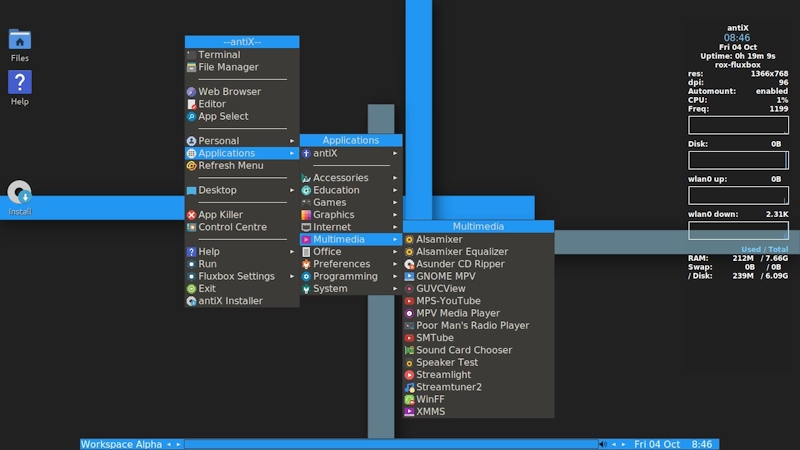First look

Just right-click anywhere on the desktop and use the menu to open any application.
The desktop is run by Fluxbox, a lightweight window manager for the X Window System that provides the display resources and functions.
Fluxbox does not use icons, but antiX has an application that can manage desktop icons for it ie ROX or SpaceFM.
Both ROX and SpaceFM come already preconfigured with some icons in antiX. Click on F6 boot menu to set icon-desktop manager.
If at desktop: Menu -→ Desktop -→ Other Desktops -→
That is the output of Conky, a light-weight system monitor that gives you real-time information on various aspects of your computer.
That is called the toolbar or panel, and it displays current info such as the workspace, open applications, background applications and the date/time.
Basic Configuration
There are 4 options, all found in the antiX Control Centre (CC): Wicd (full only), wpa-supplicant, GPRS/UMTS and ceni. antiX developers recommend ceni.
Basic Operation
To change the volume level press the Alt key, point the mouse cursor over the desktop and roll the mouse wheel up or down. Or simply click on the sound icon in the toolbar.
As in all Linux versions, personal files are located in antiX by default in the /home directory of the Linux file system.
Click Menu -→ Applications -→accessories-→Searchmonkey for files or folders.
Click Menu -→ Files to open a graphical file manager that is at the heart of the ROX desktop (see ROX section). It opens to your home directory, where you can change to view to include hidden system files by clicking on the eye icon up on the menu bar. Right-click a file to see management options.
For a command-line file manager, click Menu -→ Terminal - Type mc to bring up Midnight Commander, whose main interface consists of two panels displaying the file system with numbered commands on the bottom. Press F1 for help.
SpaceFM is another excellent file manager included with antiX. SpaceFM is a multi-panel tabbed file manager for Linux with built-in VFS, udev-based device manager, customizable menu system, and bash integration. click Menu -→ Applications -→ System Tools -→ SpaceFM
In addition to the standard operations with the three buttons in the upper-right corner, other possibilities (Send To, Layer, etc.) are available by right-clicking the titlebar. Double-clicking the title bar will shade the window. You can resize it by dragging the lower right corner. You can also group several windows in the same title bar by dragging them with the middle mouse button.
Basic Customization
Menu-→ Control Centre -→ Desktop -→ Edit Fluxbox Settings. For instance, you might want to remove the Install entry at the bottom of the Menu.
Menu -→ Control Centre -→ Desktop -→ Edit Fluxbox Settings -→ keys. Mod1 is the Alt key and Mod4 is the Super key.
Menu -→ Control Center -→ Desktop -→ Choose Wallpaper. Click on image and then Apply.
Click Menu -→ Desktop -→Desktop-→Conky on/off.
Click Menu -→Desktop-→ Fluxbox Settings -→ Here you can auto update menu, Configuration, Styles, Wallpapers, Workspace, Reconfigure, Restart.
Just right-click it to select whether it auto-hides, where it is placed, how wide it is, the clock format, etc.
Advanced
Almost anything you want. Open antiX Control Centre to see what is available.
They are in /home/username/.fluxbox, and can be viewed by clicking Menu-→ Files and then clicking on the eye symbol to show hidden files.
Links
-
[Fluxbox wiki].
-
The thread [“How I Did It”] was written originally for antiX Spartacus, but still contains some great in-depth information for the beginning antiX user.
-
Additional options about editing the Menu are explained on this [antiX Tips page].
